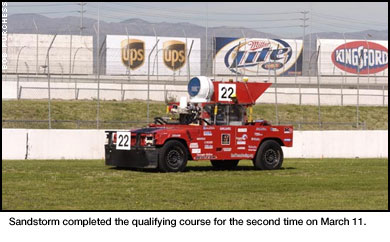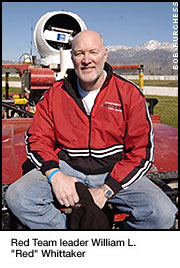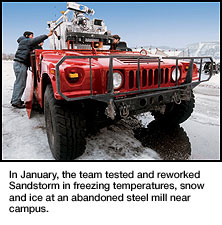|
|
||||
|
|

Red Team, Sandstorm Aim to Qualify for DARPA Grand Challenge Race will break new ground for robotic applications
In just a matter of days, months of work by the Carnegie Mellon Red Team will come to fruition when it puts its autonomous robotic vehicle to the test in qualifiers for the DARPA Grand Challenge, an unmanned, off-road race for robots. The 210-mile race through the Mojave Desert begins in Barstow, Calif., and ends near Las Vegas on Saturday, March 13. The team that completes the course—a series of waypoints will be announced just two hours before race time—in 10 hours or less will win a $1 million cash prize.
Some experts doubt the Grand Challenge can be completed this year, but the odds are on Carnegie Mellon to win. The Red Team and Sandstorm have been recently touted as top contenders in national magazines, such as Scientific American, Popular Science and Esquire. "This race will change the view of what's possible and introduce new robotic applications in the world," said team leader William L. "Red" Whittaker, the Fredkin Research Professor in Carnegie Mellon's Robotics Institute. Whittaker leads a group of some 50 Carnegie Mellon students, faculty and researchers as well as talent drawn from its pool of sponsors. The challenge lies in sensing. Any Hummer can travel 210 miles in under 10 hours, but this one can only move as quickly as it can interpret the data it receives simultaneously from maps, radar and lidar scans. "We need to have excellent sensing capability," Red Team technology leader Chris Urmson said. "The computer ride will encounter hazards a human would avoid, so we've made computer modeling of this complex terrain a priority."
Pre-mapping and routing strategies are directed by route leader Mike Clark, who describes them as "enabling capabilities for competing in the race."
Sandstorm's "eyes" consist of a laser range finder for mapping terrain combined with a stereovision system for obstacle classification and for recognizing moving objects. These sensors ride on a "neck" designed to keep the robot's scanners on the road as it bounces through rough terrain. Sandstorm also scans the horizon with radar, which adds the ability to see through dust. In addition, there is a differential global positioning system (GPS) to help Sandstorm stay on course. This is tied to a high-fidelity map that the team will create and download when DARPA releases the waypoints for the course at 4:30 a.m., March 13. During January, the team tested and reworked Sandstorm at the site of an abandoned steel mill not far from the Carnegie Mellon campus. They've endured overnight tests in freezing temperatures and a great deal of snow and ice. In February the team moved to the Mojave to begin the training in earnest. The technology developed in autonomous vehicle research has significant real world applications. Simplified versions of these systems are already benefiting consumers in the form of collision warning and avoidance systems in current high-end sedans. The technology might aid students in a driver's education course, or even some day help the elderly live more independent lives. Bringing this vehicle to life in just a matter of months is the result of true collaboration among the Carnegie Mellon Red team and its sponsors. For more information about the Red Team, see: www.redteamracing.org For more information on sponsors, see: www.redteamracing.org/sponsors For more information about the DARPA Challenge, see: www.darpa.mil/grandchallenge/
Lisa Kirchner & Anne Watzman
|
||
|
Carnegie Mellon Home |
||||
 Qualification Inspection and Demonstration trials are scheduled to take place at the California Speedway in Fontana, Calif., March 8-12. Sandstorm, the Carnegie Mellon Red Team's robotic vehicle—a 1986 HMMWV—is vying for a place among a maximum of 20 competitors that ultimately will take the field in this unique contest.
Qualification Inspection and Demonstration trials are scheduled to take place at the California Speedway in Fontana, Calif., March 8-12. Sandstorm, the Carnegie Mellon Red Team's robotic vehicle—a 1986 HMMWV—is vying for a place among a maximum of 20 competitors that ultimately will take the field in this unique contest.
 "We'll be using two terabytes of data to generate high-resolution maps of the desert," Clark said. "Our planning software will process the maps to classify the terrain, reach the waypoints, avoid difficulties, determine our speeds and optimize our route."
"We'll be using two terabytes of data to generate high-resolution maps of the desert," Clark said. "Our planning software will process the maps to classify the terrain, reach the waypoints, avoid difficulties, determine our speeds and optimize our route."